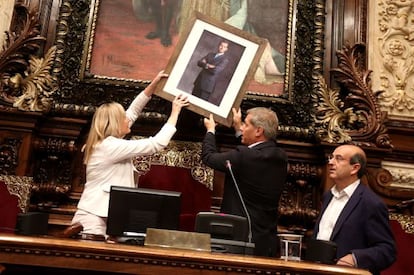PP hangs King Felipe’s portrait in Barcelona City Council chamber
Response comes a day after leftist administration removed bust of ex-king Juan Carlos I


A second chapter was written on Friday in a growing row over the presence of images of the Spanish royal family inside Barcelona’s City Council.
A day after new mayor Ada Colau, of the leftist bloc BComú, ordered a bust of former King Juan Carlos I taken down from the chamber in front of television cameras, members of the conservative Popular Party (PP) walked in with a portrait of the current monarch, Felipe VI, and placed it in the exact same spot where the bust once rested.
“After yesterday’s mockery of the monarchy, we’ve placed this image here in order to comply with the law. Colau no longer has the excuse that she doesn’t have a portrait handy,” said Alberto Fernández Díaz, the PP leader in the Catalan capital.
We feel this is a lack of respect towards the citizens of Barcelona.This is a common space. And this a republican talking to you.”
Jaume Collboni, Catalan Socialist Party (PSC)
Under a 1986 law, all council chambers must display an image of the reigning monarch, whether it’s a painting, a photograph or a bust. When the bronze likeness of Juan Carlos was removed on Thursday afternoon, municipal sources told EL PAÍS that they had no image of King Felipe VI to replace it.
The new picture did not last long in its place, however. Just a few seconds later, an employee took it down.
Mayor Colau said she was “taking note” of the message, but added that “the portrait should have been placed there a year ago,” when Felipe VI became the new king of Spain.
No laughing matter
Despite the comedic overtones, the incident illustrates growing tension in Catalonia, where the secessionist push by pro-independence campaigners has deeply divided the political class and society as a whole.
Last week, Catalan premier Artur Mas said that if his new secessionist bloc Junts pel sí wins the regional election on September 27, independence could be declared within months.
But Junts pel sí was created after Mas’ party, Democratic Convergence of Catalonia (CDC), broke up with its longtime partner Democratic Union of Catalonia (UDC) after 37 years of nearly uninterrupted joint rule in the region as CiU.
The cause of the rift was independence, which UDC does not support despite being a Catalan nationalist party. UDC veteran Josep Antoni Duran I Lleida recently said he believes Mas is being dragged by secessionists into a situation that is spiraling out of control.
This week, Felipe VI coincided with Mas at a public event in Barcelona and reminded him that the laws of the nation must be observed, a reference to the fact that a unilateral declaration of independence would violate the Spanish Constitution.
Applause and boos
The removal of the bust of Juan Carlos I was applauded by the Catalan Republican Left (ERC) and by Popular Unity Candidates (CUP), two left-wing, pro-independence parties.
ERC councilor Alfred Bosch asked for the spot to be taken up instead by “an effigy representing the only sovereign we must have in Catalonia, the Catalan people.”
But the decision drew strong criticism from other parties and politicians.
Jaume Collboni, of the Catalan Socialists (PSC), criticized a move that took place “at a plenary session on such a crucial matter as poverty.”
“We feel this is a lack of respect towards the citizens of Barcelona,” he added. “This is a common space. And this a republican talking to you.”
English version by Susana Urra
Tu suscripción se está usando en otro dispositivo
¿Quieres añadir otro usuario a tu suscripción?
Si continúas leyendo en este dispositivo, no se podrá leer en el otro.
FlechaTu suscripción se está usando en otro dispositivo y solo puedes acceder a EL PAÍS desde un dispositivo a la vez.
Si quieres compartir tu cuenta, cambia tu suscripción a la modalidad Premium, así podrás añadir otro usuario. Cada uno accederá con su propia cuenta de email, lo que os permitirá personalizar vuestra experiencia en EL PAÍS.
En el caso de no saber quién está usando tu cuenta, te recomendamos cambiar tu contraseña aquí.
Si decides continuar compartiendo tu cuenta, este mensaje se mostrará en tu dispositivo y en el de la otra persona que está usando tu cuenta de forma indefinida, afectando a tu experiencia de lectura. Puedes consultar aquí los términos y condiciones de la suscripción digital.










































